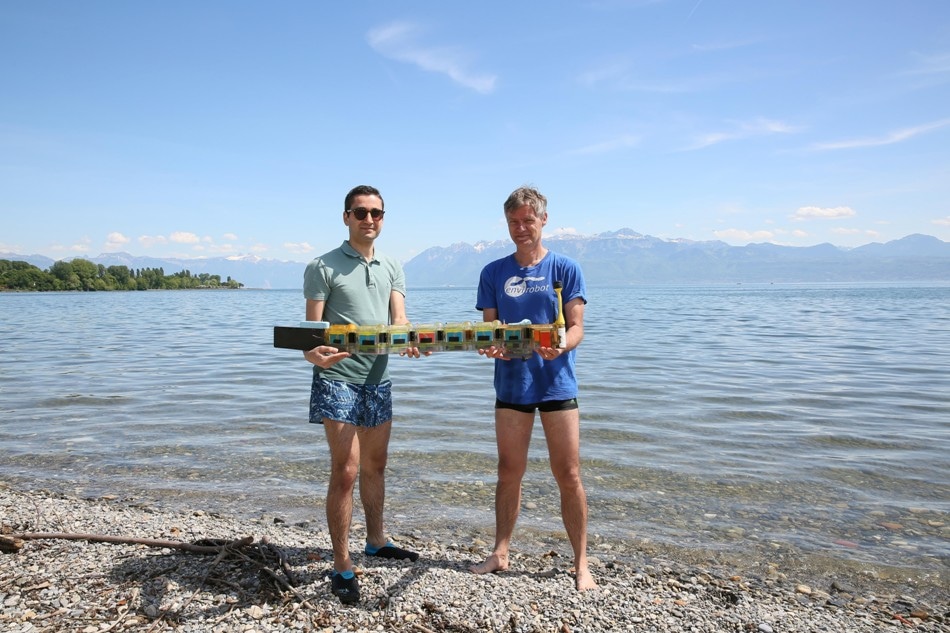Jul 26 2017
EPFL Researchers, in collaboration with other institutes, have developed a robotic eel that can swim through contaminated water to locate the source of the pollution. This sensor-equipped robot can be controlled by a remote control or move on its own. The robot was able to produce maps of water conductivity and temperature in tests performed in a small section of Lake Geneva.
 Behzad Bayat and Jan Roelof van der Meer. © Alain Herzog / 2017 EPFL
Behzad Bayat and Jan Roelof van der Meer. © Alain Herzog / 2017 EPFL
Researchers from EPFL are participating in a pioneering project funded by the Swiss NanoTera Program to design a swimming robot that can find the source of water pollution. The robot, known as Envirobot, is provided with biological, physical and chemical sensors and measures about 1.5 meters in length. It can easily move through water like an eel, without disturbing aquatic life or stirring up mud. As it swims, the robot uses its sensors to take measurements at several locations in the water and sends the information to a computer in real-time.
The robot is frequently tested in Lake Geneva. Recently, a test was performed to simulate water pollution by diffusing salt into a small section just off the shore, consequently changing the conductivity of the water. After that, the Researchers let the robot swim in the contaminated area. The robot successfully mapped the differences in conductivity and produced a temperature map. Its ultimate goal is to find heavy metals like mercury or other pollutants.
There are many advantages to using swimming robots. They can take measurements and send us data in real-time – much faster than if we had measurement stations set up around the lake. And compared with conventional propeller-driven underwater robots, they are less likely to get stuck in algae or branches as they move around. What’s more, they produce less of a wake, so they don’t disperse pollutants as much. The Envirobot can follow a preprogrammed path, and has also the potential to make its own decisions and independently track down the source of pollution.
Auke Ijspeert, Head of EPFL's Biorobotics Laboratory (BioRob)
That could be by, for example, steadily swimming in the direction of increasing toxicity.
Sensors comprised of bacteria, crustaceans and fish cells
The robot is composed of several modules that each include a small electric motor for changing curvature, allowing it to move easily through the water. The modular design also enables Engineers to change its composition and length when required.
The robot can be easily taken apart, transported to a remote water reservoir, for example, and put back together to begin testing.
Behzad Bayat, a BioRob Researcher
Some of the modules have temperature and conductivity sensors, while others contain small, sophisticated chambers that fill up with water while the robot swims. These chambers have miniaturized biological sensors that house fish cells, small crustaceans or bacteria. The sensors operate by observing how these organisms react when they come into contact with the water and thus giving an indication of the water toxicity and whether certain key pollutants are present in the water. The sensors have been highly effective in laboratory experiments.
For example, we developed bacteria that generate light when exposed to very low concentrations of mercury. We can detect those changes using luminometers and then transmit the data in the form of electrical signals.
Jan Roelof van der Meer, Project Coordinator and Head of the Department of Fundamental Microbiology, the University of Lausanne
Another process involves using two chambers filled with Daphnia, which are small crustaceans that constantly move around. One chamber is exposed to the water being examined and the other contains clean water. “The Daphnia’s movement is affected by water toxicity. By comparing changes in their movement relative to the control group, we can get an idea of how toxic the water is,” says van der Meer. And a third process comprises of growing fish cells directly on electrodes. The cells become disturbed and no longer come into contact each other when toxins are present. This interrupts the electricity flow – a change that can be easily detected.
Currently, the project team has tested only the temperature and conductivity sensors in the field; and it is very hard to perform tests of the biological sensors. “We obviously can’t contaminate a lake like we do the test water in our lab,” says van der Meer. However, tests are planned for later this summer. “For now, we will continue using salt as the contaminant until the robot can easily find the source of the contamination. Then we will add biological sensors to the robot and carry out tests with toxic compounds,” he says.
The Envirobot project, part of the Nano-Tera research program, is a joint initiative involving EPFL, the University of Lausanne, the University of Applied Sciences and Arts of Western Switzerland (HES-SO) and the Swiss Federal Institute of Aquatic Science and Technology (EAWAG). Its cross-disciplinary approach brings together Engineers, Biologists and Chemists.
Pinpointing sources of water pollution with a robotic eel